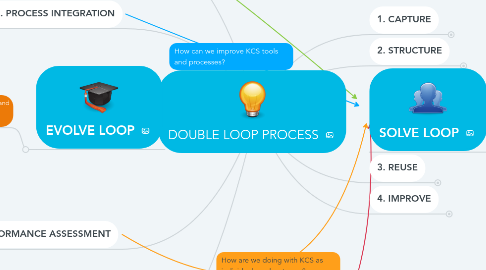DOUBLE LOOP PROCESS
af Moira McIntyre


1. 5. CONTENT HEALTH
1.1. Technique 5.1: KCS Article Structure
1.2. Technique 5.2: KCS Article State
1.3. Technique 5.3: Developing a Content Standard
1.4. Technique 5.4: Creating Evolve Loop Articles
1.5. Technique 5.5: Archiving Old Articles
1.6. Technique 5.6: Dealing With Legacy Data
1.7. Technique 5.7: Priming the Knowledge Base With New Information
1.8. Technique 5.8: Global Support Considerations
1.9. Technique 5.9: Knowledge Domain Analysis
1.10. Technique 5.10: Content Health Indicators
1.11. Technique 5.11: Self-Service Success
1.12. Technique 5.12: Self-Service Measures
2. 7. PERFORMANCE ASSESSMENT
2.1. Technique 7.1: KCS Roles and the Licensing Model
2.2. Technique 7.2: Coaching for Success
2.3. Technique 7.3: Assessing the Creation of Value
3. 6. PROCESS INTEGRATION
3.1. Technique 6.1: Structured Problem Solving
3.2. Technique 6.2: Seamless Technology Integration
3.3. Technique 6.3: Search Technology for KCS
3.4. Technique 6.4: Closed Loop Feedback for the Whole System
3.5. Technique 6.5: KCS Process Integration Indicators
4. 8. LEADERSHIP AND COMMUNICATION
4.1. Technique 8.1: Develop and Communicate a Vision
4.2. Technique 8.2: Create a Strategic Framework
4.3. Technique 8.3: KCS Benefits and ROI
4.4. Technique 8.4: Promote Teamwork
4.5. Technique 8.5: Tap into Internal Motivators
4.6. Technique 8.6: Recognition Programs
4.7. Technique 8.7: Communication is the Key
4.8. Technique 8.8: Leadership Accountability to the Knowledge Worker
4.9. Technique 8.9: Leadership and Communication Indicators
5. EVOLVE LOOP
5.1. Learn from the collection of activity and solutions created and reused in the Solve Loop
6. 2. STRUCTURE
6.1. Technique 2.1: Use A Simple Template
6.2. Technique 2.2: Complete Thoughts Not Complete Sentences
7. 3. REUSE
7.1. Technique 3.1: Search Early Search Often
7.2. Technique 3.2: Seek to Understand What We Collectively Know
7.3. Technique 3.3: Linking
8. 4. IMPROVE
8.1. Technique 4.1: Reuse is Review
8.2. Technique 4.2: Flag It or Fix It
8.3. Technique 4.3: License to Modify
9. SOLVE LOOP
9.1. Collective ownership
9.1.1. Create a solution if one doesn't exist, modify it if it does
9.1.2. Link
9.1.3. Update solution states as appropriate
9.1.4. Flag it or fix it
9.1.5. Reuse is review

